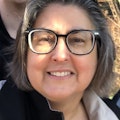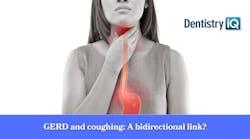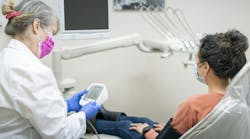7 essential oral-systemic assessments for your dental patients
The scope of dental professionals’ responsibility expands as scientific research advances and the connection between oral and systemic health becomes more mainstream. With that, dental professionals have a greater responsibility to screen their patients for health issues beyond simple caries.
There’s an ongoing need for education, yet more patients are increasingly aware of the importance of oral health on their overall well-being, and they want to be involved in their health journey.
DentistryIQ has many great resources for practitioners, and here are some of best assessments to consider using in your dental practice.
Sleep apnea and airway
One of the biggest buzzwords in dentistry today is sleep, which further solidifies the role dental professionals have in ensuring their patients’ health and lives. Ninety million people in the US report snoring problems, yet 90% of obstructive sleep apnea (OSA) cases go undiagnosed.1 Airway health is an indicator for OSA and other issues relating to oral health. Through oral assessments, practitioners can employ the tools of sleep dentistry to help patients suffering from clenching, bruxism, and sleep apnea.
How and why to screen for airway health
Oral cancer
The American Cancer Society estimates that 2024 will bring approximately 58,450 new cases of oral and oropharyngeal cancer, and with them, 12,230 deaths.2 But the earlier oral cancer can be diagnosed, the more effective treatment can be, and mortality risks will decrease. Dental professionals are in a unique position to screen their patients for early-onset cancer every few months at their recall visits.
How and why to screen for oral cancer
Elder mistreatment
The number of US adults aged 100 and older is expected to more than quadruple over the next three decades, according to the US Census Bureau.3 The older patient population is increasing, and you’re likely seeing that same trend in your dental practice. But the golden years aren’t always golden. Elder abuse is more common than you may think. Approximately 10% of US adults aged 60 and older have experienced some form of abuse, and some estimates are as high as 5 million. Yet, only one in 24 cases of abuse are reported to the authorities.4 Dental professionals are responsible for documenting and reporting instances of elder abuse. Learn more about the signs to watch for.
How and why to screen for elder abuse
Diabetes
38.4 million people in the US have diabetes (22.8% of those cases are undiagnosed), and 38% of US adults have prediabetes.5 The inflammation that occurs with periodontal diseases can lead to higher levels of blood glucose, which can contribute to a greater risk of diabetes.6 Dental professionals are well-versed with symptoms and treatments for periodontal diseases, and screening for high blood sugar is just one way to get ahead of disease states and promote oral-systemic health.
How and why to screen for diabetes
Blood pressure
Screening for blood pressure isn’t just for the physician’s office. High blood pressure and diabetes can coexist, and blood pressure can affect medications used during dental treatment (and vice versa). The American Heart Association says 46.7% of US adults have high blood pressure, and 38% are unaware they have it.7 Best practice: take blood pressure screenings on every patient at every dental visit.
How and why to screen for blood pressure
Tonsillar cancer
More than 50,000 people in the US develop oropharyngeal cancer each year, and tonsillar cancer is the most common type.8 Accumulation of bacteria (specifically group A Streptococcus) can result in infections of the tonsils.9 As dental professionals monitor the health of the oral microbiome, they can also evaluate tonsillar health during oral hygiene exams. Here’s how.
How and why to screen for tonsillar cancer
Osteoporosis
One of the many goals in dentistry is to preserve and maintain bone, as bone health plays a huge role in oral health. Approximately 10 million Americans have osteoporosis, and another 44 million have low bone density.10 Bone health is vital to healthy tooth structure and successful implant osseointegration. Panoramic radiographs are safe and excellent tools dental clinicians can use to screen patients for osteoporosis.
How and why to screen for osteoporosis
What if your patient objects to a dental screening?
Sometimes you’ll encounter patients who refuse oral assessments. Not only is this a legal liability, but patients who object to screenings are missing out on tests that directly affect their oral-systemic health. Patient education is key as you work to turn their objections into opportunities.
How to handle patient objections
Time is precious—for you and your patients
The time you have for patients’ dental appointments is valuable. It’s hard to squeeze in every type of oral assessment that would be ideal. But what better way to establish your role as an essential health-care provider and guide your patients to overall health than to offer complete care through thorough screenings?
Editor’s note: This article first appeared in Clinical Insights newsletter, a publication of the Endeavor Business Media Dental Group. Read more articles and subscribe.
References
- Forbes J. 54 shocking sleep statistics and trends for 2024. Sleep Advisor. Updated March 27, 2024. Accessed April 12, 2024. https://www.sleepadvisor.org/sleep-statistics/
- Key statistics for oral cavity and oropharyngeal cancers. American Cancer Society. Updated January 19, 2024. Accessed April 12, 2024. https://www.cancer.org/cancer/types/oral-cavity-and-oropharyngeal-cancer/about/key-statistics.html
- Schaeffer K. U.S. centenarian population is projected to quadruple over the next 30 years. Pew Research Center. January 9, 2024. Accessed April 12, 2024. https://www.pewresearch.org/short-reads/2024/01/09/us-centenarian-population-is-projected-to-quadruple-over-the-next-30-years/
- Get the facts on elder abuse. National Council on Aging. February 23, 2021. Accessed April 12, 2024. https://www.ncoa.org/article/get-the-facts-on-elder-abuse
- National diabetes statistics report: estimates of diabetes and its burden in the United States. Centers for Disease Control and Prevention. Updated November 29, 2023. Accessed April 12, 2024. https://www.cdc.gov/diabetes/data/statistics-report/index.html
- Diabetes and gum disease. American Diabetes Association. Accessed April 12, 2024. https://diabetes.org/about-diabetes/complications/oral-gum-disease
- Lewis C. More than half of U.S. adults don’t know heart disease is the leading cause of death, despite 100-year reign. American Heart Association Newsroom. January 24, 2024. Accessed April 12, 2024. https://newsroom.heart.org/news/more-than-half-of-u-s-adults-dont-know-heart-disease-is-leading-cause-of-death-despite-100-year-reign
- Oropharyngeal cancer. Cleveland Clinic. Updated February 24, 2023. Accessed April 12, 2024. https://my.clevelandclinic.org/health/diseases/12180-oropharyngeal-cancer
- Oral hygiene and tonsil health: understanding the connection. Penn Medicine Becker ENT & Allergy. Accessed April 12, 2024. https://www.beckerentandallergy.com/blog/oral-hygiene-and-tonsil-health
- Osteoporosis fast facts. Bone Health & Osteoporosis Foundation. Accessed April 12, 2024. https://www.bonehealthandosteoporosis.org/wp-content/uploads/Osteoporosis-Fast-Facts-2.pdf
Vicki Cheeseman is an associate editor in Endeavor Business Media's Dental Group. She edits for Dental Economics, RDH, Perio-Implant Advisory, DentistryIQ, and Clinical Insights.
About the Author
Vicki Cheeseman
Associate Editor
Vicki Cheeseman is an associate editor in Endeavor Business Media’s Dental Group. She edits for Dental Economics, RDH, DentistryIQ, and Perio-Implant Advisory. She has a BS in mathematics and a minor in computer science. Early on she traded numbers for words and has been happy ever since. Vicki began her career with Dental Economics in 1987 and has been fascinated with how much media production has changed through the years, yet editorial integrity remains the goal. In her spare time, you’ll find her curled up with a book—editor by day, reader always.




